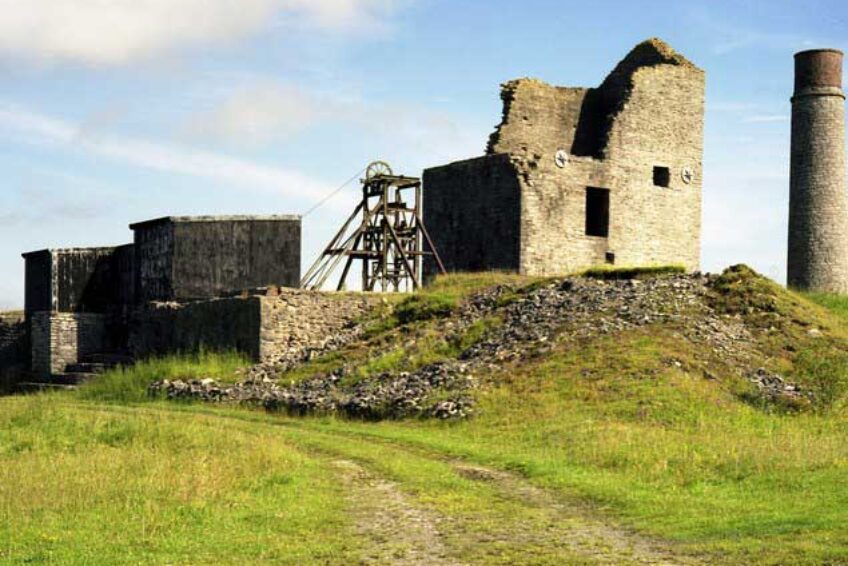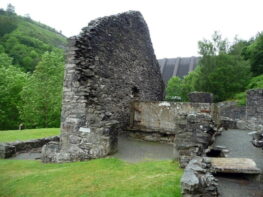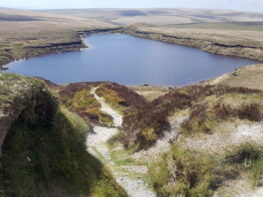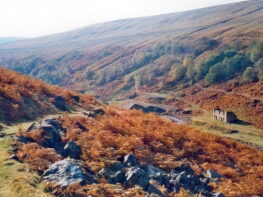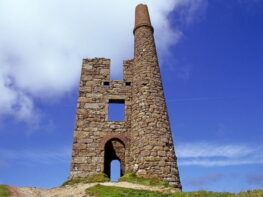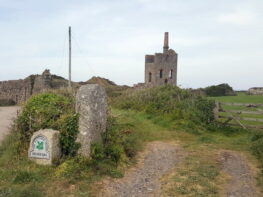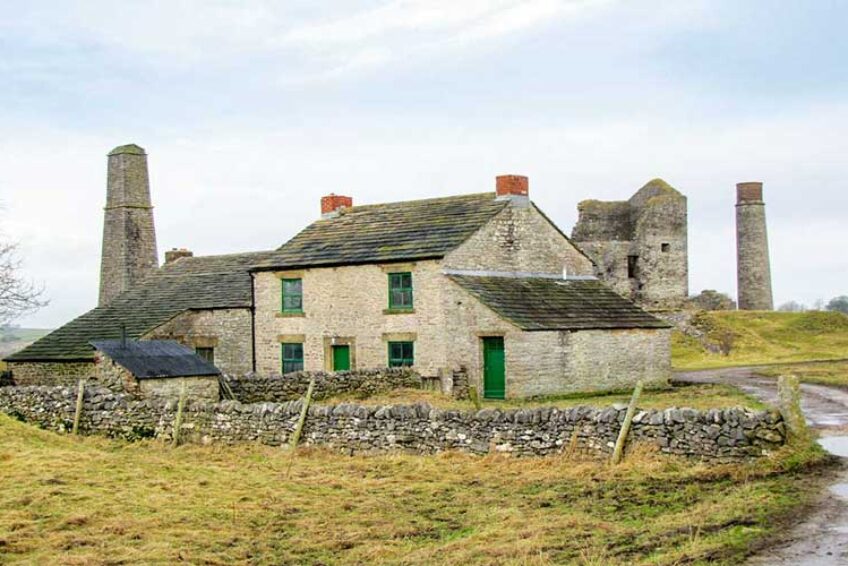
Magpie Mine is the finest example of an 18th and 19th century lead mine in Britain.
Magpie Mine is one of the Peak District’s ancient lead mines.
The area around Sheldon is riddled with a complex of narrow lead veins. Early records show that small scale working took place around 1740, the first of a dozen shafts dug within a matter of yards of each other. This first attempt doesn’t seem to have come to much, however, 20 years on and George Goodwin of Monyash decided to try his luck by sinking a shaft into the Shuttlebark Vein, close to the boundary wall to the west of the cottage. Later to be known as the Magpie Engine Shaft it was seriously deep and movement of stone and men required the efforts of a horse-gin, or engine, to reach 360 feet beneath the ground before water prevented further exploration.
This, like many others to follow, produced little if any ore.
Being abandoned, the next person to try his luck with the mine was Joshua White who successfully applied to the ancient Monyash Barmote Court to take on the mine’s title. He was probably one of the few people to make any money out of Magpie Mine for he wisely sold his shares to Peter Holme and partners. They worked the mine for another 7 years, digging narrow climbing shafts and expanding along one or two narrow veins, but even they abandoned work in 1793.
Rising prices of lead in 1801 encouraged Holme to try again, this time by taking over the rights of surrounding veins and reopening the old Shuttlebark Engine shaft in order to link the different veins. Holme and his partners were so confident of success that they celebrated the event with beef and ale! Unfortunately this confidence was short lived, for like Goodwin 9 years earlier, water prevented the miners from going any deeper; Holme is on record saying, he “could not go (further) because of the watter”.
Even using a horse gin in an attempt to lift some of the water was ineffective.
The most profitable time came in 1810 when a passage or ‘gate’ was being driven at a lower level and quite unexpectedly rich veins of lead ore were found. This was the only time Magpie Mine recorded any profitable results; £360 in a matter of a few months, quite an appreciable amount in 1813. By 1820 around £2000 had been paid out to shareholders.
By 1835 the mine had closed with only sporadic mining until a short-lived reopening in search of other minerals as well as lead, but again this came to nothing.
Magpie’s Shuttlebank Vein runs between several mines and as a result the years from 1824 to 1835 were marred by expensive legal disputes, which developed into outright quarrels! Matters came to a head in 1833, when a fire was lit by Magpie miners in a section adjoining Redsoil Mine, which killed 3 miners with sulphurous fumes. Twenty-four Magpie miners were held on a murder charge at Derby Assizes 6 months later. It was then that the crafty Brittlebank produced a statement claiming that the Redsoil agent had sent his men underground knowing the mine would be full of gas. The Magpie miners were acquitted, but not before the widows of the dead men laid a curse on the mine, which apparently still stands!
Underground water was a constant problem, so around the 1840s a ‘Cornish Engine’ was installed to lift water 684 ft from the lowest workings. The tower in which this 40-inch diameter monster was installed still dominates the site, but it was unable to cope with the ever constant flow of water – despite a 70-inch replacement, pump water continued to flood the mine. Work began to drive a drainage channel from the mine into the River Wye, which took over 8 years to complete.
Five million gallons of water still flow through it every day!
Visiting Magpie Mine today will reveal the cottage, two chimneys, headgear dating from the 1950s and a tall partly ruined engine house. Starting from the cottage, now used as a field centre by the Peak District Mines Historical Society (PDMHS), a clockwise tour reaches all these easily recognisable features.
The mine agent lived at the cottage that dates from around 1840, with the adjoining building used as a smithy. Next is the square ‘Derbyshire’ chimney built around the time of the cottage in order to serve a boiler driving a simple winding engine, or ‘whimsey’. The remains of a horse operated ore crushing circle can still be seen a little to the left, but the oddest feature is over to the left of the square chimney and towards the 1950s era winding gear – the black corrugated iron shed which housed the winding engine; it can claim to be the only Grade II listed corrugated building in Britain!
Dominating the skyline beyond the winding wheel is the tower that once housed the 40-inch and later 70-inch pumping engines prior to the sough. Only the foundations of a boiler house remain, but its circular chimney still defies the elements. Its circular design follows those powering Cornish mines and was built by a team of Cornish miners who settled in Sheldon. Square chimneys are traditionally Derbyshire design.
Moving on from the engine tower, the small circular stone structure about a hundred yards in the direction of Sheldon was used to store explosives. Its shape and deliberately weak roof meant that any accidental explosion would be directed safely upwards. If you follow the wall going to your right away from the powder store, it leads past narrow climbing shafts to a reconstructed wooden horse gin, a winding mechanism built above the site of the Redsoil ‘murders’.
In spring the field on which the remains stand is ablaze with masses of wild flowers, many quite rare, especially those such as lead wort or mountain pansy, plants which thrive on land often poisonous to other species.
Even though the climbing and winding shafts are safely capped, care must be taken when walking around this complex of the Peak District’s mining heritage.
(Information derived from Brian Spencer’s visit which can be read in full – HERE!)
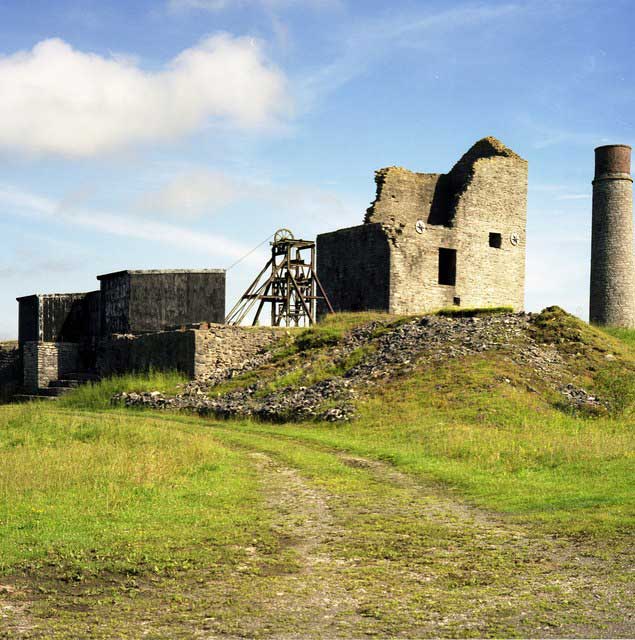
Magpie Mine is the finest example of an 18th and 19th century lead mine in Britain.
Magpie Mine is one of the Peak District’s ancient lead mines.
The area around Sheldon is riddled with a complex of narrow lead veins. Early records show that small scale working took place around 1740, the first of a dozen shafts dug within a matter of yards of each other. This first attempt doesn’t seem to have come to much, however, 20 years on and George Goodwin of Monyash decided to try his luck by sinking a shaft into the Shuttlebark Vein, close to the boundary wall to the west of the cottage. Later to be known as the Magpie Engine Shaft it was seriously deep and movement of stone and men required the efforts of a horse-gin, or engine, to reach 360 feet beneath the ground before water prevented further exploration.
This, like many others to follow, produced little if any ore.
Being abandoned, the next person to try his luck with the mine was Joshua White who successfully applied to the ancient Monyash Barmote Court to take on the mine’s title. He was probably one of the few people to make any money out of Magpie Mine for he wisely sold his shares to Peter Holme and partners. They worked the mine for another 7 years, digging narrow climbing shafts and expanding along one or two narrow veins, but even they abandoned work in 1793.
Rising prices of lead in 1801 encouraged Holme to try again, this time by taking over the rights of surrounding veins and reopening the old Shuttlebark Engine shaft in order to link the different veins. Holme and his partners were so confident of success that they celebrated the event with beef and ale! Unfortunately this confidence was short lived, for like Goodwin 9 years earlier, water prevented the miners from going any deeper; Holme is on record saying, he “could not go (further) because of the watter”.
Even using a horse gin in an attempt to lift some of the water was ineffective.
The most profitable time came in 1810 when a passage or ‘gate’ was being driven at a lower level and quite unexpectedly rich veins of lead ore were found. This was the only time Magpie Mine recorded any profitable results; £360 in a matter of a few months, quite an appreciable amount in 1813. By 1820 around £2000 had been paid out to shareholders.
By 1835 the mine had closed with only sporadic mining until a short-lived reopening in search of other minerals as well as lead, but again this came to nothing.
Magpie’s Shuttlebank Vein runs between several mines and as a result the years from 1824 to 1835 were marred by expensive legal disputes, which developed into outright quarrels! Matters came to a head in 1833, when a fire was lit by Magpie miners in a section adjoining Redsoil Mine, which killed 3 miners with sulphurous fumes. Twenty-four Magpie miners were held on a murder charge at Derby Assizes 6 months later. It was then that the crafty Brittlebank produced a statement claiming that the Redsoil agent had sent his men underground knowing the mine would be full of gas. The Magpie miners were acquitted, but not before the widows of the dead men laid a curse on the mine, which apparently still stands!
Underground water was a constant problem, so around the 1840s a ‘Cornish Engine’ was installed to lift water 684 ft from the lowest workings. The tower in which this 40-inch diameter monster was installed still dominates the site, but it was unable to cope with the ever constant flow of water – despite a 70-inch replacement, pump water continued to flood the mine. Work began to drive a drainage channel from the mine into the River Wye, which took over 8 years to complete.
Five million gallons of water still flow through it every day!
Visiting Magpie Mine today will reveal the cottage, two chimneys, headgear dating from the 1950s and a tall partly ruined engine house. Starting from the cottage, now used as a field centre by the Peak District Mines Historical Society (PDMHS), a clockwise tour reaches all these easily recognisable features.
The mine agent lived at the cottage that dates from around 1840, with the adjoining building used as a smithy. Next is the square ‘Derbyshire’ chimney built around the time of the cottage in order to serve a boiler driving a simple winding engine, or ‘whimsey’. The remains of a horse operated ore crushing circle can still be seen a little to the left, but the oddest feature is over to the left of the square chimney and towards the 1950s era winding gear – the black corrugated iron shed which housed the winding engine; it can claim to be the only Grade II listed corrugated building in Britain!
Dominating the skyline beyond the winding wheel is the tower that once housed the 40-inch and later 70-inch pumping engines prior to the sough. Only the foundations of a boiler house remain, but its circular chimney still defies the elements. Its circular design follows those powering Cornish mines and was built by a team of Cornish miners who settled in Sheldon. Square chimneys are traditionally Derbyshire design.
Moving on from the engine tower, the small circular stone structure about a hundred yards in the direction of Sheldon was used to store explosives. Its shape and deliberately weak roof meant that any accidental explosion would be directed safely upwards. If you follow the wall going to your right away from the powder store, it leads past narrow climbing shafts to a reconstructed wooden horse gin, a winding mechanism built above the site of the Redsoil ‘murders’.
In spring the field on which the remains stand is ablaze with masses of wild flowers, many quite rare, especially those such as lead wort or mountain pansy, plants which thrive on land often poisonous to other species.
Even though the climbing and winding shafts are safely capped, care must be taken when walking around this complex of the Peak District’s mining heritage.
(Information derived from Brian Spencer’s visit which can be read in full – HERE!)

